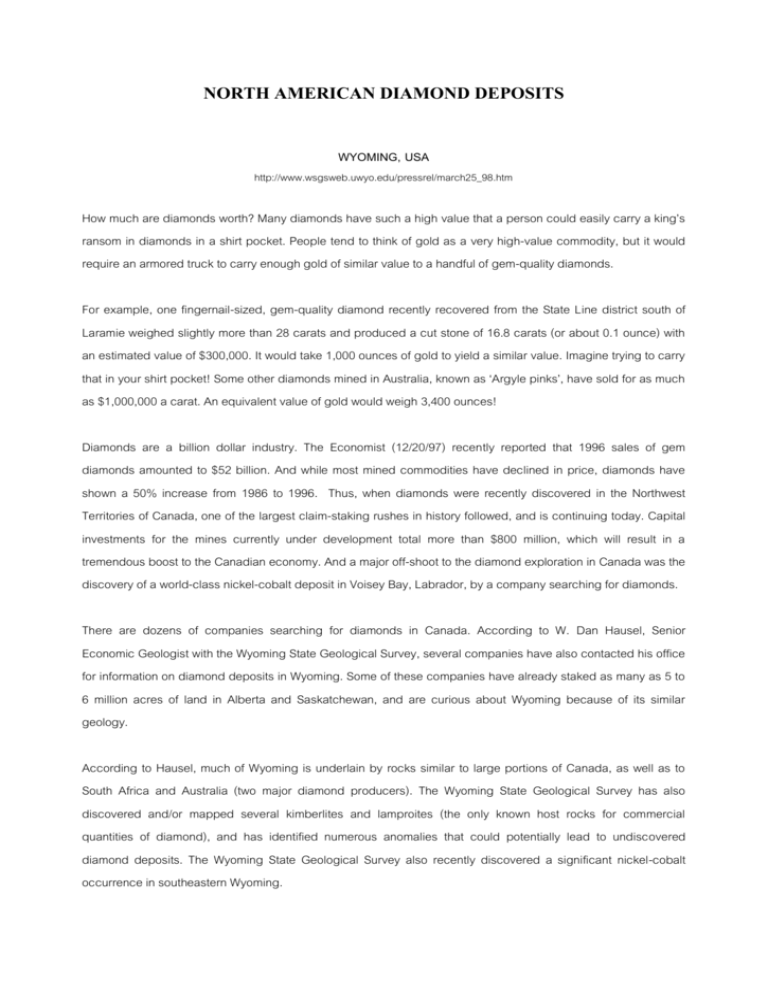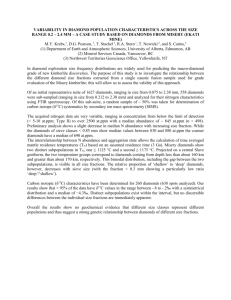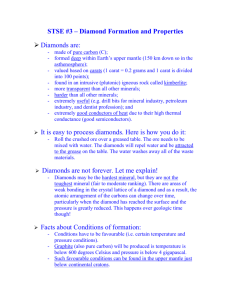north american diamond deposits
advertisement

NORTH AMERICAN DIAMOND DEPOSITS WYOMING, USA http://www.wsgsweb.uwyo.edu/pressrel/march25_98.htm How much are diamonds worth? Many diamonds have such a high value that a person could easily carry a king’s ransom in diamonds in a shirt pocket. People tend to think of gold as a very high-value commodity, but it would require an armored truck to carry enough gold of similar value to a handful of gem-quality diamonds. For example, one fingernail-sized, gem-quality diamond recently recovered from the State Line district south of Laramie weighed slightly more than 28 carats and produced a cut stone of 16.8 carats (or about 0.1 ounce) with an estimated value of $300,000. It would take 1,000 ounces of gold to yield a similar value. Imagine trying to carry that in your shirt pocket! Some other diamonds mined in Australia, known as ‘Argyle pinks’, have sold for as much as $1,000,000 a carat. An equivalent value of gold would weigh 3,400 ounces! Diamonds are a billion dollar industry. The Economist (12/20/97) recently reported that 1996 sales of gem diamonds amounted to $52 billion. And while most mined commodities have declined in price, diamonds have shown a 50% increase from 1986 to 1996. Thus, when diamonds were recently discovered in the Northwest Territories of Canada, one of the largest claim-staking rushes in history followed, and is continuing today. Capital investments for the mines currently under development total more than $800 million, which will result in a tremendous boost to the Canadian economy. And a major off-shoot to the diamond exploration in Canada was the discovery of a world-class nickel-cobalt deposit in Voisey Bay, Labrador, by a company searching for diamonds. There are dozens of companies searching for diamonds in Canada. According to W. Dan Hausel, Senior Economic Geologist with the Wyoming State Geological Survey, several companies have also contacted his office for information on diamond deposits in Wyoming. Some of these companies have already staked as many as 5 to 6 million acres of land in Alberta and Saskatchewan, and are curious about Wyoming because of its similar geology. According to Hausel, much of Wyoming is underlain by rocks similar to large portions of Canada, as well as to South Africa and Australia (two major diamond producers). The Wyoming State Geological Survey has also discovered and/or mapped several kimberlites and lamproites (the only known host rocks for commercial quantities of diamond), and has identified numerous anomalies that could potentially lead to undiscovered diamond deposits. The Wyoming State Geological Survey also recently discovered a significant nickel-cobalt occurrence in southeastern Wyoming. With declining oil production in Wyoming, a diamond industry could help off-set declining revenues. But it takes considerable time and effort to find, identify, and develop diamond deposits. Unfortunately Wyoming will probably not see a rush on the same scale as Canada. This is not because Wyoming does not have the potential to host major diamond deposits. According to Hausel, Wyoming is every bit as favorable, but the Canadian government is providing exploration incentives, something the U.S. Government is not doing. With so much of the mineral estate in Wyoming owned by the Federal government, incentives could make a difference. However, Hausel is optimistic that significant diamond discoveries in Wyoming will attract the attention of the diamond industry. Already, the Wyoming-Colorado State Line district south of Laramie has produced several of the largest diamonds found in North America, including diamonds of 2.6, 5.51, 6.2, 9.4, 10.5, 11.85, 14.2, 16.9, 28.18, and 28.3 carats. Diamonds have also been found in several other regions of the State. ARKANSAS, USA http://www.state.ar.us/agc/gemstone.htm Arkansas Diamond-bearing Rocks One of the few places in North America where diamonds are present in their host rock and the only place tourists may hunt for diamonds is the Prairie Creek pipe in Arkansas. It is roughly triangular in surface outcrop, exposed over 73 acres, and is situated 2.5 miles southeast of Murfreesboro in Pike County. The site has been known to geologists since 1842. It is a breccia-filled volcanic pipe of Cretaceous age, formed by a series of gaseous explosions as are several other pipes nearby. Various rock types are present in the Arkansas diamondiferous pipes. Magmatic lamproite is a dark-colored igneous rock with a texture that has two distinct grain sizes (porphyritic). Some of it was broken explosively as it neared the earth's surface. This broken rock material is lamproite breccia tuff. Rarely have diamonds been reported in the soils formed by the weathering of magmatic lamproite; most have been recovered in the lamproite breccia tuff or in the thin residual soils overlying this rock. Microdiamonds, however, have been recovered from the magmatic rock by special techniques. Epiclastic rock, which is a rock formed by the mechanical mixing of tuffaceous volcanic material and local Cretaceous sediments, was recently recognized by geologists. Arkansas History Diamonds were first discovered in Arkansas in 1906 when two stones were picked up by John M. Huddleston near the mouth of Prairie Creek southeast of Murfreesboro. Following this discovery, diamonds were reported from two small areas 2 miles to the northeast of the Prairie Creek pipe. Later, various efforts were made to mine diamonds on a commercial basis, but without sustained success. In 1919, the Arkansas Diamond Corporation was organized and a washing plant was built which processed 18,000 loads of surface-mined diamond-bearing material in 1920. The corporation discontinued operations after 9 months. Early in 1940, the property was taken over by The Diamond Corporation of Arkansas. Their 2,000-ton washing and concentrating plant began operation in 1948, but shut down a year later. Howard A. Millar operated the "Crater of Diamonds" tourist attraction on part of the Prairie Creek pipe during the 1950’s and 1960’s. This volcanic pipe and some surrounding acreage became Crater of Diamonds State Park in 1972 when the State of Arkansas purchased the property for $750,000 from General Earth Minerals. From 1972 to 1996 inclusive, 1,895,143 guests had visited the Park. Recovery figures are incomplete, but estimates are that about 100,000 diamonds, thought to average 0.25 carats in weight, have been recovered by commercial efforts and by tourists. Since the Prairie Creek pipe became a state park in 1972, the state has maintained records of the number of diamonds discovered and reported. From 1972 to 1997 inclusive, 21,068 diamonds weighing a total of 4,195.34 carats have been reported (Tom Stolarz, personal communication). It is not known what percentage of the stones from Arkansas are of industrial grade. In the early 1990’s, drill-hole data on the Prairie Creek pipe indicated about 78 million tons of diamond-bearing rock are present to a depth of 650 feet. Several nearby diamond-bearing lamproite pipes are present northeast and east of the state park on private property. Arkansas Diamonds The 1967 Arkansas General Assembly passed legislation which became Act 128 designating diamond as the official gem of the State. To qualify as gem-grade, diamond must meet several criteria. It should be large enough to cut a stone whose value is more than the cost of cutting and the cost of the rough stone. An octahedral-shaped diamond allows the production of the largest brilliant round cut with the least waste. Even when faceted to this ideal shape, which possesses the most fire for the finished weight, a given diamond crystal will lose about 50 percent of its weight. The rough or uncut stone must be clear and not contain major inclusions or flaws. Diamonds not meeting the grader’s standards are termed industrials. Total lack of color is usually considered to be of the highest value. However, some particularly strong or unusual colors are highly valued, such as canary yellow, pink, or blue. Pale yellow, brown, and green are considered inferior colors for gemstones. A number of diamonds recovered from the volcanic pipes near Murfreesboro qualify as gem-grade material. The largest diamond discovered in the United States came from this site and was recovered by commercial methods. Named the "Uncle Sam", this diamond was discovered in 1924. It weighed 40.23 carats in the rough, and was faceted into an elongate emerald-cut gemstone weighing 12.42 carats. It has a faint rose color and is presently owned by Peiken of Fifth Avenue, New York. The best known diamond recovered by a tourist is the "Star of Arkansas", a white 15.33-carat crystal which was faceted to a flawless 8.27-carat marquise-shaped gem. This stone was auctioned at Christie's of New York in 1994 and brought $145,000. The largest diamond discovered since the beginning of Crater of Diamonds State Park in 1972 is the "Amarillo Starlight", weighing 16.37 carats. This stone was faceted to a 7.54-carat marquise-shaped gem, valued at between $150,000 and $175,000. Numerous smaller stones from Arkansas have been cut or left as natural crystals and utilized in jewelry. First Lady, Hillary Clinton, wore a natural diamond crystal set in a gold ring, during the 1992 Presidential Inaugural Ball in Washington, D. C. This diamond crystal weighs 4.25 carats, is strong canary-yellow in color, and possesses a natural brilliant luster. Records of diamonds discovered at Crater of Diamonds State Park for the period of 1972 to 1999, inclusive, indicate that diamonds were reported that weighed over 1 carat each (Tom Stolarz, personal communication). Some of these stones would qualify as cuttable gemstones. A particularly notable recently discovered diamond that was cut and found to be a flawless perfect top quality colorless stone is the Stawn-Wagner diamond. It weighed 3.03 carats rough and was cut to a brilliant round gem of 1.09 carats. Gemologists have graded the stone as grade D-flawless, 0/0/0 (cut, color, clarity) and stated that this diamond is one in a billion! It was purchased by the Crater of Diamonds State Park for $34,500, using part grant money and part private donations in 1999. This flawless gem may be viewed on special occasions at the Park. One notable find of a gem-grade diamond is reported from White County in 1926. A young girl picked up a pretty stone while working in a cotton field. It was later identified as a 27.21-carat gem-quality diamond. In 1946, the finder, Mrs. Pellie Howell, sold this uncut stone to Tiffany & Company of New York for $8,500. Still in Tiffany's possession, it is of a fine cape (pale yellow) color, has not yet been cut, and is the third largest diamond so far discovered in the United States. Some believe that this single stone was originally discovered by a Native American at or near the Prairie Creek pipe and dropped near Searcy where it was later found. There are no geologic or geophysical indications of diamond-bearing pipes in northeast Arkansas. References Howard, J. M., 1989, Finding diamonds in Arkansas!, Arkansas Geological Commission pamphlet. Krol, L. G., 1988, Prairie Creek kimberlite (lamproite), in Colton, G. W., ed., Proceedings of the 22nd Forum on the Geology of Industrial Minerals: Arkansas Geological Commission Miscellaneous Publication 21, p. 73-75. DIAMOND DEPOSITS OF CANADA http://www.nrcan.gc.ca/gsc/mrd/mdag/pub/diamonds_e.html#intro1 Diamonds, though extremely rare, are widely distributed and have been discovered in unconsolidated and consolidated sediments, diverse igneous rocks of upper mantle origin, mantle xenoliths, ophiolites, ultra high pressure metamorphic rocks, meteorites and impact structures. Of these, only diamond-bearing kimberlite and lamproite, and their derived placer and paleoplacer deposits, have proven to be economically viable. Before 1960, >80% of all diamonds were recovered from secondary deposits; by 1990, increased diamond production from kimberlite and lamproite pipes reduced this to <25% (Levinson et a1., 1992). Nearly two thirds of present world production by weight comes from only five pipes located in Australia, Botswana, Russia, and South Africa (Boucher, 1995). Kimberlites occur in continental shield areas, and economic kimberlite are associated with the stable parts of Archean (>2.5 Ga) cratons. Lamproites, on the other hand, typically intrude demobilized Archean cratons or Proterozoic orogenic belts. For example, the Argyle deposit in Australia, the world's most productive diamond mine, occurs in a lamproite pipe within the Proterozoic Halls Creek mobile belt. Locations of diamond-bearing rocks in Canada are shown in Figure 1, along with the locations of many commercially important kimberlites and lamproites. This figure also shows the worldwide distribution of Archean and Proterozoic cratons based on a generalized geological map of the world, now available digitally (Kirkham et al., 1994, 1995). Figure 1. Locations of diamond-bearing kimberlites in Canada, and worldwide locations of kimberlite clusters and primary diamond producers and past producers. The distribution of Archean and Proterozoic rocks is derived from a digital geological map of the world compiled by Kirkham et al. (1994, 1995). In Canada, Archean and Proterozoic structural provinces are well known and geological maps provide a rigorous framework for examining the distribution of kimberlites and for testing models of diamond formation. Precambrian rocks of the North American craton have been subdivided into numerous crustal domains with distinctive ages, structural trends, and geophysical characteristics (Stockwell, 1961; Hoffman, 1989). Archean cratons, which underlie a large part of the exposed Canadian Shield, were welded together by Proterozoic orogeny, many of which continue in the sub-surface beneath adjacent Phanerozoic sedimentary cover (e.g. Trans-Hudson orogen Fig. 1: Percival, 1996). The contrast between exposed Archean fields and adjacent thinly covered Proterozoic orogeny is one characteristic that hints at significant differences between Archean and Proterozoic processes of lithosphere formation and preservation (Durrheim and Mooney, 1994). The continental lithosphere, made up of the crust and part of the upper mantle, is a strong persistent layer relative to the underlying convecting asthenosphere. Seismological studies indicate that the lithosphere is thicker beneath Archean cratons, and contains regions of cool lithospheric mantle within the diamond stability field (i.e. depths >150 km; Durrheim and Mooney, 1994; Grand, 1994; Polet and Anderson, 1995). The first three papers in this volume provide a brief summary of the complex history of Archean cratons and flanking Proterozoic orogeny in Canada, and contain key references to maps and reports on the Precambrian geology of Canada. In this volume, the geology of kimberlites and lamproites is covered in summary papers, accompanied by short papers on analytical methods and specific kimberlite fields in Canada. For comprehensive summaries of the petrology of kimberlites, lamproites, and lamprophyres the reader is referred to books by Mitchell (1986; 1995), Mitchell and Bergman (1991) and Rock (1991). Extensive additional information can be obtained from the Proceedings Volumes for the five International Kimberlite Conferences published up to 1994, and in the Abstracts Volume for the Sixth International Kimberlite Conference (*Proceeding Volumes, 1979-1994; Abstracts Volume, 1995). Kimberlites resemble and can be spatially associated with other alkaline rocks, some of which originate at depths >150 km, and are therefore potentially diamond-bearing. Diamonds have been reportedly recovered from lamprophyre diademe breccias in the Canadian Cordillera, from lamprophyre dykes and diatremes south of Baker Lake, N.W.T., and from the Ile Bizard diatreme breccia in Quebec. These diamond-bearing rocks and several other alkaline intrusions in Canada are described in a series of short Papers. Kimberlite, lamproite and other alkaline magmas originate as small volume melts of deep-seated origin. The triggering mechanism for generation of kimberlites is unknown, and correlation of kimberlite magnetism with mantle plumes, with flexure of the lithosphere, or with specific plate tectonic processes has not been adequately demonstrated worldwide (Mitchell, 1986; Haggerty, 1994). Furthermore, no viable theory has accurately predicted the location of kimberlite fields within a craton, although many fields have preferred orientations that suggest preexisting structural controls are important. Lamproites and lamptophyres originate from shallower sources than kimberlites, and magmas are derived from partial melting of subcontinental lithospheric mantle that has a long and complex metasomatic history (Mitchell and Bergman, 1991). Kimberlites have chemical and isotopic signatures suggesting they originated from sources in the asthenosphere, although the magmas can be modified by interaction with metasomatized regions in the overlying continental lithosphere (Haggerty, 1994; Ringwood et al., 1992; Tainton and McKenzie, 1994). Much of our knowledge of the deep crust and upper mantle is inferred indirectly from geophysical methods. Mantle and crustal xenoliths and xenocrysts transported to surface by deep-seated magmas are actual samples of the mantle and deep crust, and can be used to test the geophysical models and study the lithosphere beneath Canada. Pilot studies provide a glimpse of the rich potential provided by xenolith suites in kimberlites and related rocks, discovered as a result of the continued success of diamond exploration across Canada. Age determinations on diamond inclusions and on primary minerals in diamond-bearing kimberlites indicate that diamonds are xenocrysts in the kimberlite magma. Kimberlites act only as transportation agents, bringing diamonds and mantle xenoliths from within the diamond stability field to the surface. In general, diamonds are disserllinatead throughout the kimberlite host, although xenoliths of diamond-bearing source rocks, such as eclogite and rare peridotite, are known. Of unique interest in some kimberlites are down-dropped blocks of country rocks. Emplacement processes involved in near-surface diadems and crater formation produced kimberlites containing numerous country rock fragments, some of which are the only preserved evidence for stratigraphic units that have now been removed by erosion. Papers on fossil-bearing xenoliths recovered from Lac de Gras kimberlite summarize new and surprising information about the age and geological setting of pipe formation. Mafic magmatic events generated by mantle plumes and rifting are potentially destructive to the cool diamondbearing roots of continental lithosphere (Helmstaedt and Gurney, 1994). Large-scale mafic dyke swarms are a surface record of these thermal events, and their age, source, and distribution provide evidence about possible selective destruction or preservation of diamond-bearing mantle roots. Conceptually, diamond formation and preservation is linked to areas of thick and cool continental lithosphere which extend into the diamond stability field in the mantle (depths >150 km). However, diamonds apparently unrelated to such old cratoric nuclei have been discovered associated with Phanerozoic collisions orogeny, such as in New South Wales, Eastern Australia (Barron et a1., 1994), and diamonds occur in other off-craton localities. Diamonds have been recovered from alluvial sources proximal to technically emplaced ultramafic massifs in collisions orogeny, and microscopic diamonds have been discovered in situ in fault-bounded ultra high pressure metamorphic massifs. In addition, microscopic diamonds occur in carbon-bearing rocks at impact sites worldwide and, to date, no systematic search has been made of the twenty-six known impact structures in Canada. Three papers in this volume summarize these associations and outline the Canadian context. Although none of these unusual diamond occurrences worldwide has proven to be of major economic importance, interest is piqued by rocks from ophiolites, such as the Beni Bousera ult.ramafic massif, that has been interpreted to have initially contained up to 15% diamond (Nixon et a1., 1991). References A.N. LeCheminant, D.G. Richardson, R.N.W. DiLabio and K.A. Richardson, (ed.), 1996. Searching for diamonds in Canada: Geological Survey of Canada Open File 3228. Lac de Gras Diamond Exploration http://sts.gsc.nrcan.gc.ca/page1/miner/gras1.htm Introduction As part of the Slave Province National Mapping Program, Terrain Sciences Division mapped the surficial geology of Winter Lake (NTS 86A), Lac de Gras (76D) and Aylmer Lake (76C) map areas, which contain most of the diamond-bearing kimberlites in the Northwest Territories. The project involved helicopter-assisted ground work including terrain mapping at a scale of 1:125 000, till sampling, and measuring of ice flow indicators. For these three map areas, a total of 194 10 kg till samples were collected from shallow pits for heavy mineral and gold grain analysis, and 500 additional samples were analyzed for trace element geochemistry. The study was undertaken in part to establish regional patterns and background values of kimberlite indicator minerals in an area of known kimberlites, so that mineral exploration companies working in the area would have regional information to guide their exploration programs at a property scale. Ice-flow history In the Lac de Gras and Aylmer Lake map areas, mapping of striations yielded the following ice-flow sequence from oldest to youngest: southwest, west and northwest. The dominant ice-flow, most responsible for transport of the glacial sediment, is westward and northwestward; however in the northeast part of 76C, a late southwestward flow is also significant. In the Winter Lake map area, flow is generally towards the west-northwest in the northern and central regions, and towards the west in the southern region. A younger set of westward trending striae cross-cuts an older set with an northwestward orientation in the Lake Providence-Beauparlant Lake area. Preliminary results A total of 2273 suspected indicator minerals (i.e. pyropes, diopsides >1 wt.% Cr2O3, magnesian-ilmenites and chromites) were identified. Approximately 474 mineral grains were analyzed by electron microprobe, of which 60% were garnets (pyrope and almandine-spessartine), 11% were pyroxenes (chrome-diopsides), 26% were ilmenites and the remaining 3% were other minerals and alteration products (leucoxene, hematite and (Ti)magnetite). Total concentrations of indicator minerals ranged from 0 to >1000 grains per 10 kg sample. The majority of the indicator minerals were found in the 0.25-0.5 mm size fraction. In this fraction, 94 of the 194 samples contained indicator minerals, whereas in the 0.5-1.0 mm size fraction only 20 samples contained indicator minerals. The relative proportion of indicator minerals for the entire data set is ~73% pyropes, ~24% chrome-diopsides, ~2% magnesian-ilmenites, ~1% chromites and <<1% eclogitic garnets. The results to date show a higher proportion of pyrope garnets in the 0.25-0.5 mm size fraction. Regional patterns The regional distribution of kimberlite indicator minerals reveals variability in concentrations which strongly reflects the ice flow history and the principal zone of known kimberlites for the area. Samples with the highest concentrations of indicator minerals occur in the northern half of the Lac de Gras map area, either adjacent to or down ice from known clusters of kimberlite pipes. Abundant sites with low concentrations of indicator minerals were found in the Winter Lake map area; conversely, very few indicator minerals occur in the Aylmer Lake map area. Because of this distribution, what is considered a background or anomalous value of kimberlite indicator minerals varies throughout the region from map sheet to map sheet. Based on a sample density of one sample/165 km2, the following background and anomalous values should be considered approximate. The low numbers of indicator minerals in the Aylmer Lake map area suggests that background values are near zero and any indicator minerals found in this area should be considered anomalous. In the Winter Lake area, background values are relatively high with most samples containing several indicator minerals; therefore, only samples with 710 indicator minerals would be considered anomalous. The sample to the southwest of Winter Lake, containing almost 100 indicator minerals, is clearly anomalous. The southern portion of the Lac de Gras map area also contains few indicator minerals, but because of the ice flow history of the area, indicator minerals present could be from kimberlites to the west and northwest; therefore, samples containing >3 indicator minerals would be considered anomalous. Many of the samples in the northern portion of the Lac de Gras map area can be considered anomalous in the regional perspective but because the number of indicator minerals is highly variable over a small area, determining what is anomalous is difficult; it is likely that 15-20 indicator minerals are anomalous in this area. The highest concentration of indicator minerals represents the combined signature of the kimberlites to the north of Lac de Gras. However, concentrations of indicator minerals are quite variable over relatively small distances. This variability is likely caused by the small size of kimberlites and the resulting restricted width of their dispersal trains. The regional distribution of the indicator minerals also reflects the glacial history of the area. The abundance of samples with low concentrations of indicator minerals in the Winter Lake map area can be explained mainly by glacial dispersal from the Lac de Gras cluster; earlier phases of southwestward and westward flow could have caused this diffuse pattern. This would imply that many of the indicator minerals in this area could have undergone >150 km of glacial transport. The Ekati Diamond Deposits http://www.diamet.com/ekati_diamond/index.html Two to three hundred kilometres below us, the high temperature and deep pressure of the earth's upper mantle join forces to crystallize pure, simple carbon into diamonds. They would remain there, locked below the earth's surface and impossible to re cover, if it weren't for one of the planet's most violent events. Cross-section of typical kimberlite pipes. Diamonds share the earth's mantle with kimberlite magma, a volatile mixture of molten fluids, rocks and minerals. When the magma finds a crack in the planet's crust, it exploits it, traveling upward in "pipes" until decreasing pressure near the surface of the earth causes the magma's gasses to rapidly separate and expand, resulting in an explosive volcanic eruption. The sticky, smoldering magma that initiates kimberlite volcanoes carries with it many geological passengers to the earth's surface. The most notable of these are diamonds. • The oldest diamonds were formed three billion years ago. • Newer diamonds are crystallized from carbon in segments of ocean floors that have been thrust downward to the earth's mantle by continental drift. • A total of 121 kimberlite "pipes" (actual volcano sites) have been discovered in the Ekati™ claim area. By 1985, after collecting diamond-indicating soil samples for nearly a decade, Canadian geologist Charles Fipke had followed a trail of kimberlitic minerals (those left on the earth's surface in the aftermath of kimberlite volcanoes) to the Lac de Gras region of the Northwest Territories. Six years later, with the help of an enthusiastic new partner, BHP Minerals, Fipke and his crew discovered the area's first ancient kimberlite volcano or "pipe" under Point Lake. In the fall of 1991, they recovered 81 diamonds from a 58 kilogram core sample and triggered the largest staking rush in Canadian mining history. Although the overall diamond quality from the Point Lake pipe was modest, the find was very encouraging because a number of rare, colourless diamonds larger than one carat had been discovered. Those results prompted BHP to fund an extensive geophysical survey of the entire claim block, and that survey led to the discovery of a highly valued, significant gem supply that is characterized by the beautiful, often flawless white stones the Ekati™ Mine has since become famous for. Seven years after the first diamonds were discovered in the Northwest Territories, the Ekati™ Diamond Mine officially opened on October 14, 1998. Three months later, regular sales of rough Ekati™ diamonds began in Antwerp, Belgium. Construction of the largest installation ever built north of the Canadian tree line posed many logistical challenges, not the least of which was marshaling the thousands of truckloads of supplies necessary and having them ready to travel on an often treacherous ice road that was opened only a handful of weeks each winter. Because the mine had an ambitious 18-month construction schedule, timing was everything. If any crucial supplies missed the narrow travel window afforded by the ice road, the project could be set back an entire year. The second major challenge was actually moving more than 40 million kilograms of freight safely over a 440kilometre bed of ice through one of the harshest climates in the world. Somewhat remarkably, both of these challenges were met without delay, and the constructed mine now includes a 55-million-litre fuel tank farm, a power plant with five 4.4-megawatt generators, a processing plant that moves 440 tonnes of material an hour and a huge residential facility that includes a gym, running track and racquet court, among other facilities. The fact that the Ekati™ construction project was completed on time, on budget and with an award-winning safety record is a testament to the dedication and creativity of the team that got the job done in the face of enormous odds. It would take close to $700 million US and nearly a decade of planning, approvals and labour to build a facility to mine the kimberlite ore from the Ekati™ claim area and process it to recover rough industrial and gem quality diamonds. Feasibility plans for the mine call for five different kimberlite pipes to be mined in the area using a combination of open-pit and underground techniques. The mine plan remains dynamic based on exploration results; it has already been altered to replace one pipe (Leslie) with a more economic one (Sable). Because of this and continuing exploration, Dia Met and BHP Diamonds, its Ekati™ Mine joint-venture partner, expect the mine will have a life longer than the 17 years forecast in its original feasibility study. The total life of Canada's first diamond mine is projected to be 25 years or more. In that time, Ekati™ will produce three to five million carats of rough industrial and gem quality diamonds a year. That amounts to approximately four percent of current world diamond production by weight and six percent by value. In January 1999, the world was introduced to North America's first diamonds when regular sales of rough Ekati™ stones began in Antwerp, Belgium. More than half of the world's consumption of rough, polished and industrial diamonds passes through this major trading centre, and still the quality of the Canadian product made a strong impression. In fact, demand for Ekati™ diamonds since their debut in Antwerp has been greater than ever anticipated, not just because of their high quality, but because Ekati™ stones offer an attractive combination of things not usually found in the diamond industry: a consistently high quality product; a reliable supply; and a stable source country. While the Ekati™ Mine's marketing program evolves to take advantage of changes in the diamond industry, three main marketing channels remain for Ekati™ diamonds: • De Beers: 35 percent of run-of-mine production is now sold to De Beers. • Antwerp Sales Office: The remaining 65 percent of Ekati™ production is sold to clients from all major manufacturing centres through a sales office in Antwerp, Belgium. • Northwest Territories Manufacturers: About 10 percent of the value of Ekati™ production will be made available to manufacturers in the Northwest Territories, creating the potential for a small but important diamond and jewelry manufacturing industry in Canada's North.





